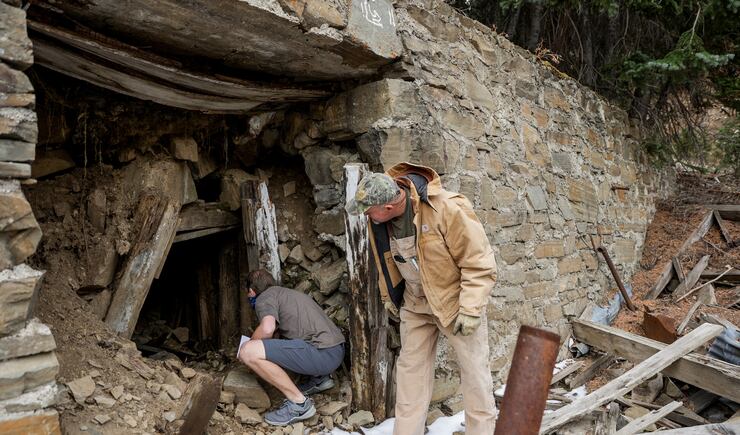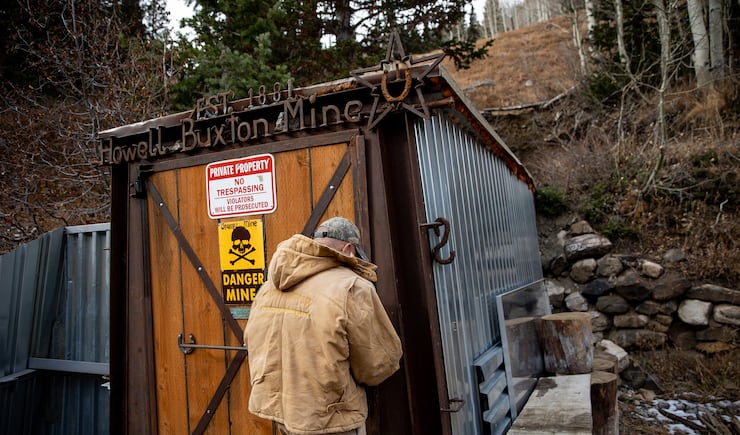COTTONWOOD HEIGHTS — Cyle Buxton wanted to close an abandoned mine on his property in Cardiff Canyon because of what he said was a steady stream of trespassers and fears that someone could get hurt, despite his signs to stay out.
So, over the years he worked to enclose the mine with a steel door but left it accessible to him along with an old wood stove and camping gear inside.
Little did he know he would incur nine civil violations this summer for his actions.











Unaware of the trouble to come, he built a snowshed in 2014 that extended over the mine opening so he could access it despite mounds of snow. Such structures were common in the days of legacy mining so crews could pile up waste rock without enduring the drifts of fine white powder and soggy conditions.
Since July, however, Buxton has been embroiled in a legal fight with the Salt Lake County District Attorney’s Office and the Greater Salt Lake Municipal Services District because he failed to get a construction permit, his structure is “habitable” and they assert what he built is too close to an ephemeral stream.
Buxton said the intermittent stream was nowhere near his work when he first started construction and often doesn’t flow at all depending on the amount of winter snowpack.
Now, months later, Buxton is on the cusp of working out what he hopes is a legal compromise with the municipal services district and the district attorney’s office.
It is a fight and compromise that tore through his savings and retirement accounts because he hired a lawyer to help him navigate what he says has been a bureaucratic nightmare involving multiple layers of governmental entities with oversight over the canyons.
“I did have a rainy day account, a savings account, but it is all gone,” Buxton said. “I think there is a target on my back because I own property in the canyon.”
Salt Lake County authorities and officials with the municipal services district say that assertion is nonsense — if you break the rules there are consequences.
The county attorney’s office, citing county ordinances, said Buxton was required to get a permit and did not. What he built was not a mine closure, but a habitable structure and the construction happened too close to an intermittent stream in a critical watershed.
“At the time the notice of violation was issued, it appeared that Mr. Buxton had done more than just close off a mine but had built an additional structure. Salt Lake County’s actions were not in response to mine safety but in response to building, zoning and water quality violations,” according to the district attorney’s office.
The office went on to add, however, that the county has no regulatory authority over an abandoned mine structure that has fallen into disrepair and is not a danger to health and human life.
Buxton contends the crumbling mine opening was dangerous, especially given the frequency of trespassers, and the hillside the mine was built into was starting to slough off. The opening was in partial collapse at one point and was being dug out and accessed by trespassers, he said, adding he believed his work would help prevent any subsequent collapse.
Both soil and structural engineers have inspected the mine closure at Buxton’s request, as well as the director of the Utah Division of Oil, Gas and Mining’s Abandoned Mine Reclamation program.
That director, Steve Fluke, said there are no regulatory standards in place throughout Utah on what a mine closure should look like. When his division has closed mines on private or government property in the canyons, he said there’s never been a requirement to get a permit.
“We have our own in-house standards” that the division applies on mine closures, he said. “But there are no regulatory standards or requirements for how an abandoned mine is closed.”
Fluke said he understood the county wanted the snowshed taken out because of the lack of a permit.
“Personally, I think it is rather neat. Historically they had these snowsheds so they could work in the snow and extend the portal out over the dump in the area.”
Fluke said the door was solidly built and secured and if it were taken away, the mine opening could collapse.
The engineer’s report agreed with that conclusion.
“During the site visit (the engineer) walked inside the portal with Mr. Buxton. The mine portal had been drastically improved (safety and cosmetics) from other historic mines in the area. The steel framing appeared to have been constructed in a workmanlike manner similar to other mine shaft improvements observed by this writer,” said the report by Gordon Geotechnical Engineering.
Due to sloughing of soils surround the mine portal, the report added that removing the structure would cause dangerous erosion issues.
“Based on the surrounding topography, it appears that simply removing the portal structure will create an unstable condition and hazard to the public. Additional remediation requiring significant earthwork would be required to eliminate the public safety hazard,” the report said.
Removal of improvements, it noted, would create a significant hazard while leaving it as it existed would have little to no impact.
At first, Buxton said county officials insisted just the snowshed be removed, and Buxton took it out this fall. They then followed up with the demand the door also be taken off the mine opening.
The door secures an opening that leads to a milelong tunnel that Buxton said over the years trespassers have tried to explore.
“It’s really dangerous and a liability,” he said.
Fluke says there are an estimated 150 mine openings in the Wasatch canyons on public and private property. While there used to hundreds more, about three decades ago, the division reached out to owners to see if they were willing to have them closed.
Many of the owners opted out of the free service, but a recent outreach led to about two-thirds of property owners willing to take the division’s help. The division has also worked on multiple mine closure projects in the canyons over the years with owners’ permission.
“It is their liability, but we can’t force them to close them. It is their responsibility to look after it,” Fluke said. “But we do everything and it does not cost them a thing. They just have to give us a written right of entry.”
In 2012, during a tour of Cardiff Canyon by the head of the Utah Department of Natural Resources, Buxton said he was told there are inherent dangers with mine openings such as his, so he said the following year he secured the portal with a metal door and later added the snowshed.
The municipal services district flagged his property for potential violations in 2018 and last year, on the advice of his attorney, Buxton said he abandoned any use of the portal other than for inspection.
But Buxton said that did not cause the county to abandon its case, something he feels is part of a larger effort targeting private property owners like him.
He added about 20 years ago, Salt Lake City made him an offer on the property as part of its watershed protection efforts, but he turned it down.
“They don’t want us to do anything with our property. They want it devalued so they can get it for pennies on the dollar.”
County officials insist the violations stem not from mine safety issues but are in response to building, zoning and water quality violations.
“Anytime anyone is going to build a structure on a property they have to submit an application for a building permit,” said Maridene Alexander, communications manager for the Greater Salt Lake Municipal Services District, which pursued the violations against Buxton.
The district also leveled action against another Cardiff property owner who had a Conex container hauled to his land.
Wayne Crawford modified the storage container to serve as a recreational vehicle and said it is registered with the Utah Division of Motor Vehicles in that category with its own vehicle identification number.
His case with the district attorney’s office is now closed, but Crawford said the demand to remove it from his property frustrated him. He asserts county ordinances are being selectively enforced.
“I cannot find where the (district) regulates camping trailers parked on private property in the Foothills and Canyons Overlay Zone nor any support for this extreme interpretation in the ordinances,” he said.
But Alexander said Crawford illegally put the structure on his land and it does not resemble any sort of a recreational vehicle.
“If either structure (the trailer or the mine) is being used for habitable space the owner needs to go through the building permit process in addition to getting land use approval,” Alexander said. She later clarified that statement to say Crawford didn’t need a building permit, but because of the geographic location he should have gone through multiple regulatory reviews to determine if the trailer was permitted on his property.
She added that in Buxton’s case, any additions he made to the mine opening resembled less of a closure and more of a space designed to spend the night, making it a violation of county ordinances that govern what can or cannot happen in the Wasatch canyons.
The Cottonwood Heights resident, in a negotiation with the district attorney’s office, submitted an application in December to the municipal services district to have a nonconforming structure left on his property — the door.
It’s unclear what decision the municipal services district will make, and Alexander said it is premature to describe what a possible outcome would be such as a denial, a request for more information, approval or additional demolition work that may be required to remove the door. She expects a determination to be made in early 2021.
Buxton said he fears the district wants the door removed or bulldozed and his application will be rejected.
According to legal documents prepared by Buxton’s attorney, the civil engineer said removal of the door could exacerbate soil erosion and possibly lead to the collapse of a road above his property.
Fluke, too, said generally speaking, it doesn’t make sense to require removal of a portal.
“If you took away the portal the mine would collapse where it is opening,” he said. “There are a lot of unconsolidated materials before you get to bedrock.”
Dea Theadore, who was elected to the Salt Lake County Council in November and whose district covers the Wasatch canyons, said the Buxton case is concerning.
“If the county is going to regulate mine closures and enforce what people do on their property, then we need a fair and equitable process,” she said.
“My understanding is that the county does not have a set process, standards or even a manual for private landowners and others to follow in order to close and secure these mines to prevent accident or injury. As a county we need to be more involved,” Theodore said. “We either need to work with the (state) or combine our resources so the county can create its own process for private landowners on closing these mines.”
Buxton is now in a wait-and-see mode to find out the fate of the mine on his property.













